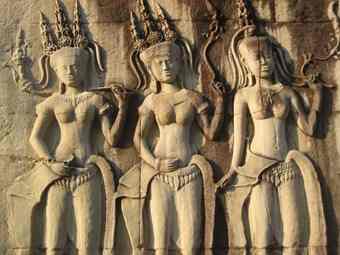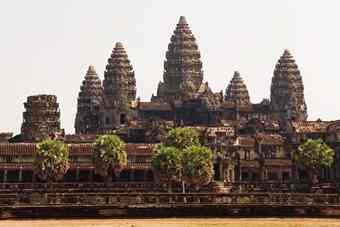Amid the splendour of the 12th-century temple at Angkor Wat, they stand and stare like silent sentinels, sensuous rather than erotic, carved with elegance and care.
 But exactly who are these 1786 mysterious women and why, more than a century after Cambodia's famed Hindu temple was rediscovered by Western archaeologists, did it take the efforts of an amateur US researcher to push experts into trying to resolve the puzzle?
But exactly who are these 1786 mysterious women and why, more than a century after Cambodia's famed Hindu temple was rediscovered by Western archaeologists, did it take the efforts of an amateur US researcher to push experts into trying to resolve the puzzle?
Though Kent Davis had lived in Southeast Asia during the 1990s, he did not see Angkor Wat until 2005.
Like most visitors to the huge complex, for many years cut off from the outside world because of the Khmer Rouge, he was mesmerised.
But he also left with a flurry of questions. "I went to Angkor as a tourist and I was startled when I got there to notice these women," said Davis, 54, a publisher and writer who now lives near Tampa, Florida.
"I was not prepared for it. The human element of them struck me and I wanted to know who they were. I asked one of the guides and he said they were there to serve the king after he went to heaven."
Davis vowed he would return to the US and investigate. Yet when he got home he found there was essentially nothing written about these women, who appear throughout the temple complex in full body carvings.
![Bas relief of Apsara dancers [detail]](http://lh3.ggpht.com/_BfC6j03vee0/TIsdkN3PU2I/AAAAAAAAE5E/VrldM1HMN6M/angkor_wat_detail_thumb%5B3%5D.jpg) Indeed, the only study of the female carvings he could find had been made in the early 20th century by the daughter of Frenchman Henri Marchal, then the site's curator.
Indeed, the only study of the female carvings he could find had been made in the early 20th century by the daughter of Frenchman Henri Marchal, then the site's curator.
Five years and several trips to Angkor later, Davis has slowly begun to get some answers.
After turning to Michigan University computer experts for help, a team was able to conduct facial mapping experiments on digital photographs of the women, or devatas.
The team, whose findings were presented last month at the International Conference on Pattern Recognition, an academic convocation in Istanbul, concluded there were at least eight different facial types, perhaps reflecting a variety of ethnicities in the Khmer kingdom.
The results are to be examined further by archaeologists and more computer mapping is planned. But despite all the mapping, the results of which were published in DatAsia magazine, many questions about the women remain unanswered.
"There are almost 1800 women's faces there," said Davis, who is now trying to use 65 separate characteristics to place the faces in a database.
![Bas relief of Apsara dancer [detail]](http://lh6.ggpht.com/_BfC6j03vee0/TIsdkmXYkyI/AAAAAAAAE5I/4ywF1fdgjk4/angkor_wat_apsara_thumb%5B3%5D.jpg) "It's a Facebook of the 12th century, but no one had ever heard of them. This was the biggest temple the Khmer people ever built and it must have been important to them because they threw everything into it.
"It's a Facebook of the 12th century, but no one had ever heard of them. This was the biggest temple the Khmer people ever built and it must have been important to them because they threw everything into it.
"They would have put important things in it; these women must have been important to the kingdom."
Davis wrote to universities, pestered experts, and sought the opinions of people from around the globe who had worked at Angkor.
Dr Peter Sharrock, an expert on Southeast Asia at London's School of African and Oriental Studies, has studied the temples around Angkor for years. "We understand [the female carvings] little but they play a major role in the architectural sculpture of these temples, which must imply a major role in the beliefs of the ancient Khmers and in the rituals in their temples," he said.
"Khmer descent was primarily matrilineal, and Khmer women were literate and powerful. Many were queens, and most kings base their genealogies and claims to the throne on their female ancestors."
Davis said analysing the images was like "being the first person to get a map to the British Museum and the keys to the front door".
"Once we define facial types more thoroughly, [by] using facial pattern recognition on people living in this area ... we could actually find the descendants of some of the sacred women in the temple."
 ANGKOR WAT
ANGKOR WAT
What: A sprawling temple complex.
Where: Located amid dense jungle and close to the city of Siem Reap.
History: It was built in the early 12th century and is one of a series of stunning palaces built over a 400-year period by the Khmer Kingdom. Angkor Wat, the most impressive and best-preserved of the complexes, was built for King Suryavarman II and is dedicated to the Hindu god Vishnu.
Khmer Rouge: For many years the remarkable buildings were unknown to the West, which only "rediscovered" them in the 19th century. During the 1970s and 1980s they were off-limits as a result of the presence of the Khmer Rouge, the Maoist-inspired rebels who ruled Cambodia from 1975-79 and who then engaged in a bitter civil war for the next two decades.
Today: The temples attract up to a million tourists a year. Angkor Wat has become a symbol of Cambodia, even appearing on its national flag.
Source: New Zealand Herald [September 10, 2010]
 ANGKOR WAT
ANGKOR WAT